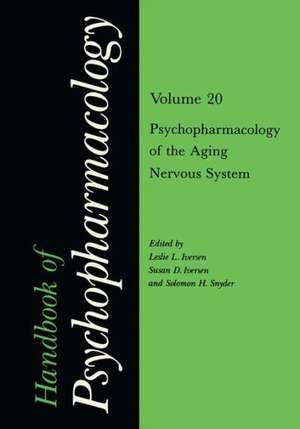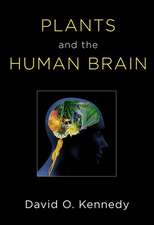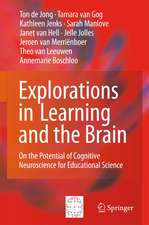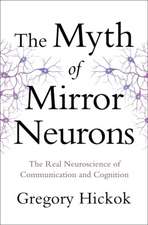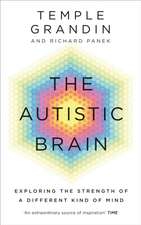Handbook of Psychopharmacology: Volume 20 Psychopharmacology of the Aging Nervous System
Editat de Leslie L. Iversen, Susan D. Iversen, Solomon H. Snyderen Limba Engleză Paperback – 26 sep 2011
| Toate formatele și edițiile | Preț | Express |
|---|---|---|
| Paperback (3) | 383.93 lei 6-8 săpt. | |
| Springer Us – 26 sep 2011 | 383.93 lei 6-8 săpt. | |
| Springer Us – 12 dec 2012 | 727.24 lei 6-8 săpt. | |
| Springer Us – 2 noi 2011 | 736.55 lei 6-8 săpt. |
Preț: 383.93 lei
Preț vechi: 404.13 lei
-5% Nou
Puncte Express: 576
Preț estimativ în valută:
73.47€ • 76.42$ • 60.66£
73.47€ • 76.42$ • 60.66£
Carte tipărită la comandă
Livrare economică 15-29 aprilie
Preluare comenzi: 021 569.72.76
Specificații
ISBN-13: 9781461282525
ISBN-10: 1461282527
Pagini: 504
Ilustrații: XVIII, 500 p. 21 illus.
Dimensiuni: 170 x 244 x 26 mm
Greutate: 0.79 kg
Ediția:1988
Editura: Springer Us
Colecția Springer
Locul publicării:New York, NY, United States
ISBN-10: 1461282527
Pagini: 504
Ilustrații: XVIII, 500 p. 21 illus.
Dimensiuni: 170 x 244 x 26 mm
Greutate: 0.79 kg
Ediția:1988
Editura: Springer Us
Colecția Springer
Locul publicării:New York, NY, United States
Public țintă
ResearchCuprins
1 Neuropathological and Neurochemical Aspects of Alzheimer’s Disease.- 1. Introduction.- 2. The Neuropathology of Alzheimer’s Disease.- 3. Alzheimer-Type Changes in Conditions Other than Alzheimer’s Disease.- 4. Alzheimer’s Disease and Patient Age.- 5. Biochemical Correlates of Pathological Changes.- 6. Relationship between Plaques and Tangles and Nerve Cell Atrophy and Loss.- 7. Relationship between Extent of Pathological Changes and Degree of Dementia.- 8. Pathogenetic Considerations.- 9. Concluding Remarks.- 10. References.- 2 Basal Forebrain Cholinergic Neurons and Alzheimer’s Disease.- 1. Introduction.- 2. Basal Forebrain Cholinergic Systems.- 3. Cholinergic Alterations in AD.- 4. Cholinergic Physiology.- 5. Conclusion.- 6. References.- 3 Neurochemical Studies in Dementia.- 1. Introduction.- 2. Alzheimer’s Disease.- 3. Other Cortical Dementias.- 4. Subcortical Dementias.- 5. Alcohol Dementia.- 6. Confusional States.- 7. Summary.- 8. References.- 4 Chemical Neuroanatomy of Alzheimer’s Disease.- 1. Introduction: Relationship of Neural Connections and Neurotransmitters with Alzheimer Pathology.- 2. Limbic and Cortical Connections and Neurotransmitters in Alzheimer’s Disease.- 3. Brain Stem and Basal Forebrain-Cortical Connections and Neurotransmitters in Alzheimer’s Disease.- 4. Implications for the Pathogenesis and Treatment of Alzheimer’s Disease.- 5. References.- 5 Dementia in Parkinson’s Disease.- 1. Introduction.- 2. Brain Lesions in Patients with Parkinson’s Disease.- 3. Dementia and Lesions.- 4. Parkinsonian Dementia.- 5. Symptoms and Lesions.- 6. Conclusion.- 7. References.- 6 Alzheimer’s Disease: Genetic Theories of Etiology.- 1. Introduction.- 2. The Genetic Hypothesis.- 3. Critical Methodological Issues.- 4. PredictedCharacteristics of Genetically Caused AD.- 5. Review of Previous Studies.- 6. Current Studies.- 7. Implications and Strategies for Future Research.- 8. References.- 7 The Cholinergic Hypothesis of Memory: A Review of Animal Experiments.- 1. Introduction.- 2. Conceptual Issues.- 3. Methodological Issues.- 4. Anatomy of Forebrain Cholinergic Pathways.- 5. Pharmacology of Central Cholinergic Neurons.- 6. Pharmacological Evidence for Cholinergic Involvement in Sensory, Attentional, and Motor Functions.- 7. Pharmacological Studies of Rodent Learning and Memory.- 8. Lesion Studies.- 9. Pharmacological Studies of Primate Memory.- 10. Summary and Concluding Remarks.- 11. References.- 8 Behavioral Models of Aging in Nonhuman Primates.- 1. Introduction.- 2. Some Characteristics of Age-Related Behavioral Deficits in Nonhuman Primates.- 3. Relationship of Age-Related Behavioral Deficits in Nonhuman Primates to Humans.- 4. Relationship of Age-Related Behavioral Deficits in Nonhuman Primates to Rodents.- 5. Possible Insights from Comparisons with Nonhuman Primates Given Discrete Brain Lesions.- 6. Possible Insights from Drugs That Impair Performance on Memory Tasks in Young Subjects.- 7. Drugs for Improving Age-Related Cognitive Losses: Current Status and Future Prospects.- 8. Synthesis and Discussion.- 9. References.- 9 Cholinergic Drugs and Human Cognitive Performance.- 1. Introduction.- 2. The Effects of Cholinergic Agents on Processes Involved in Learning and Memory in Experimental Animals.- 3. The Effects of Cholinergic Agents on Processes Involved in Learning and Memory in Young Adult Human Subjects.- 4. Clinical Trials of Cholinergic Agents in Patients with Dementia of the Alzheimer Type or Aged Volunteers.- 5. Implications and New Directions.- 6. References.- 10 Treatment ofDementia with Vasoactive Drugs.- 1. Background and Rationale.- 2. Traditional Vasodilators.- 3. Recent Developments and Future Prospects.- 4. References.- 11 New Pharmacological Perspectives on Nootropic Drugs.- 1. Introduction.- 2. Known Compounds.- 3. Goals of This Chapter.- 4. Distribution of Drugs in Brain.- 5. Neuropsychopharmacological Studies.- 6. Neurochemical Studies.- 7. Relationship to Endogenous Substances.- 8. Nootropic Drugs and Arguments for Supplementary Choline.- 9. Clues to the Mode of Action of Nootropic Drugs.- 10. Some Thoughts on Clinical Trials.- 11. Summary and Conclusion.- 12. References.
Descriere
Descriere de la o altă ediție sau format:
It is now eight years since the first Handbook volumes on Basic Neuro pharmacology were published, and there have been many important advances. As in many other areas in science, progress in this field has depended to a considerable extent on the availability of new experimental methods, and Volume 15 reviews some major recent developments, including new autoradiographic techniques that allow direct visualization of drug and transmitter receptors in the nervous system, and the pin pointing of the precise locations of the changes in brain metabolism elicited by various drug treatments. Volumes 16 and 17 cover two of the most active areas for basic research in psychopharmacology at the moment: the characterization of drug and transmitter receptors in brain by radioligand binding techniques, and studies of the role of small peptides in brain function. The latter area, in particular, illustrates how rapidly progress continues to be made in basic research on the mechanisms of chemical communication within the nervous system. Eight years ago when the Handbook first appeared none of the opioid peptides (enkephalins and endorphins) had yet been identified. Since then a whole new area of basic biological research has focused on these substances, and in addition we know of more than thirty other neuropeptides with putative eNS trans mitter functions.
It is now eight years since the first Handbook volumes on Basic Neuro pharmacology were published, and there have been many important advances. As in many other areas in science, progress in this field has depended to a considerable extent on the availability of new experimental methods, and Volume 15 reviews some major recent developments, including new autoradiographic techniques that allow direct visualization of drug and transmitter receptors in the nervous system, and the pin pointing of the precise locations of the changes in brain metabolism elicited by various drug treatments. Volumes 16 and 17 cover two of the most active areas for basic research in psychopharmacology at the moment: the characterization of drug and transmitter receptors in brain by radioligand binding techniques, and studies of the role of small peptides in brain function. The latter area, in particular, illustrates how rapidly progress continues to be made in basic research on the mechanisms of chemical communication within the nervous system. Eight years ago when the Handbook first appeared none of the opioid peptides (enkephalins and endorphins) had yet been identified. Since then a whole new area of basic biological research has focused on these substances, and in addition we know of more than thirty other neuropeptides with putative eNS trans mitter functions.
